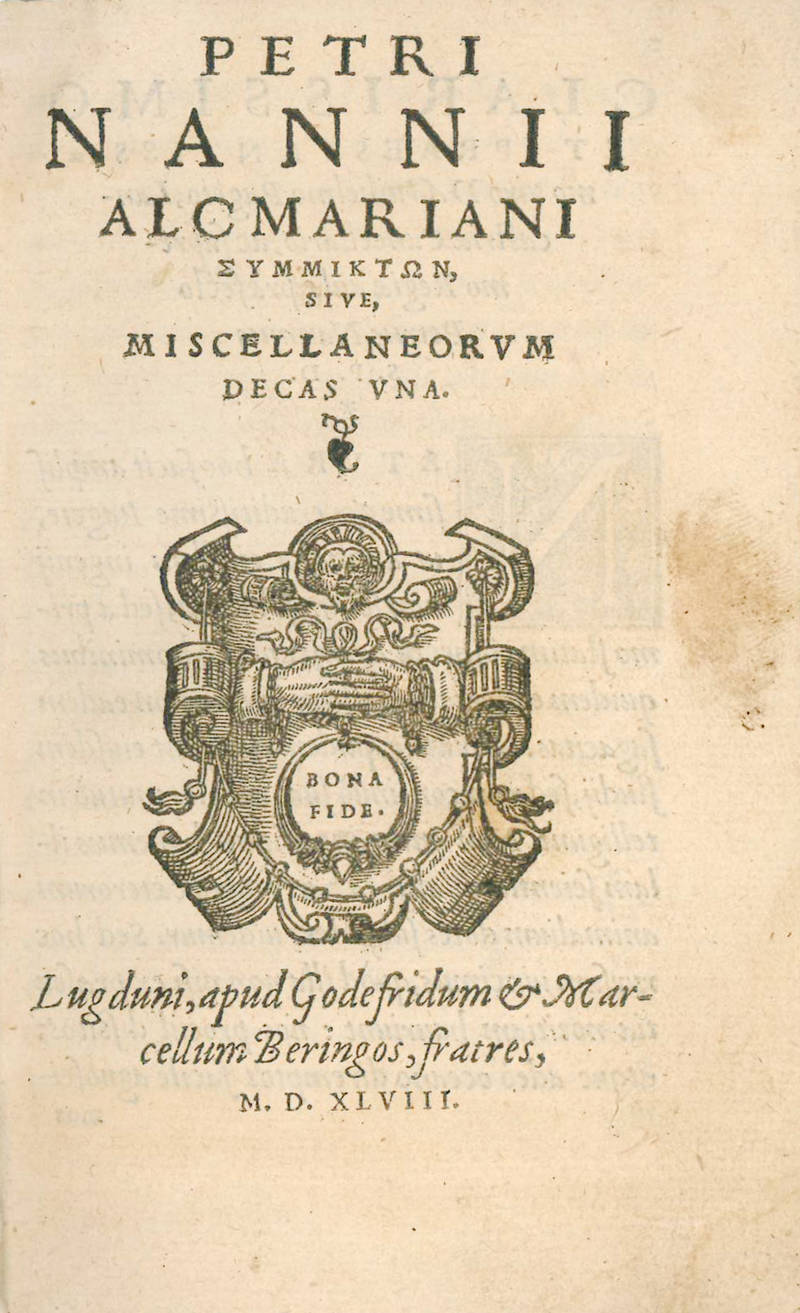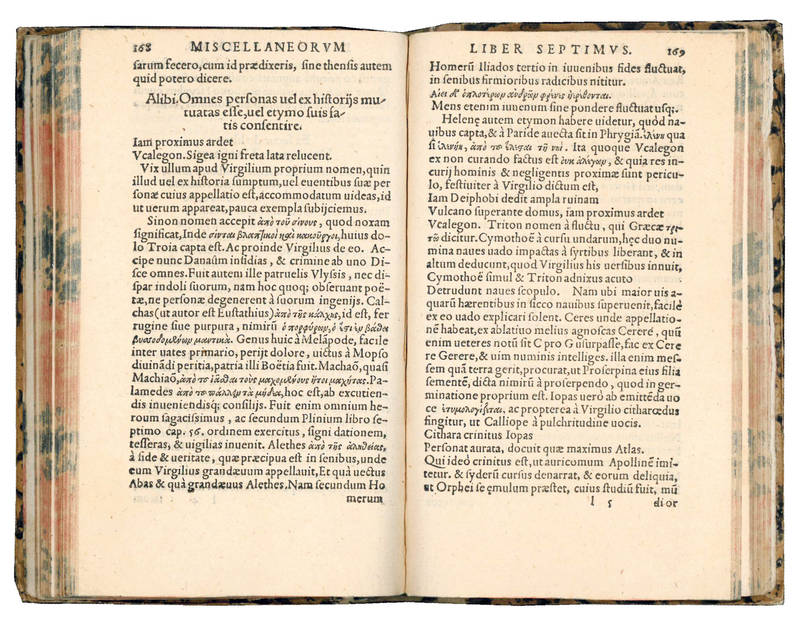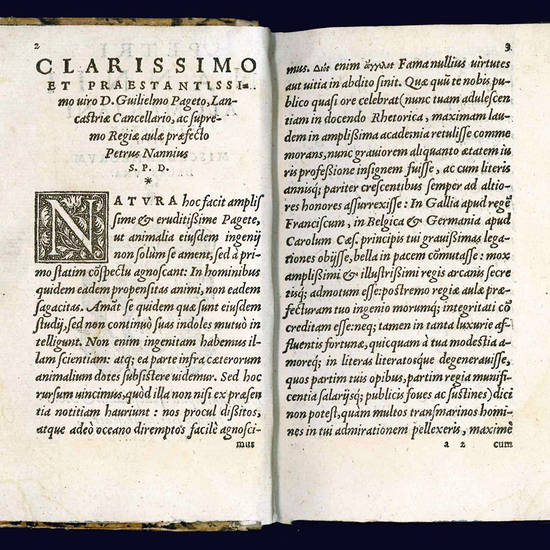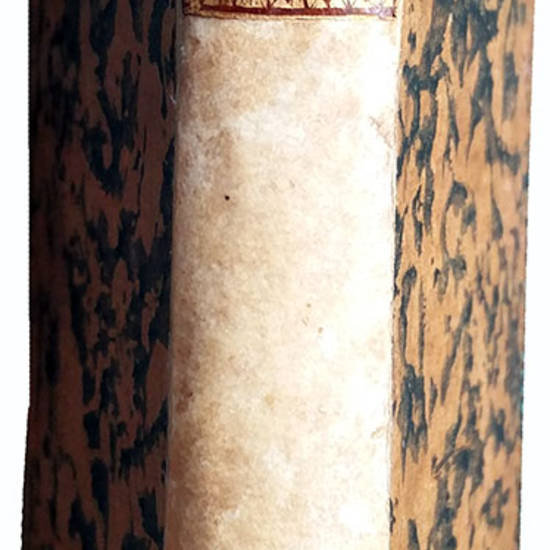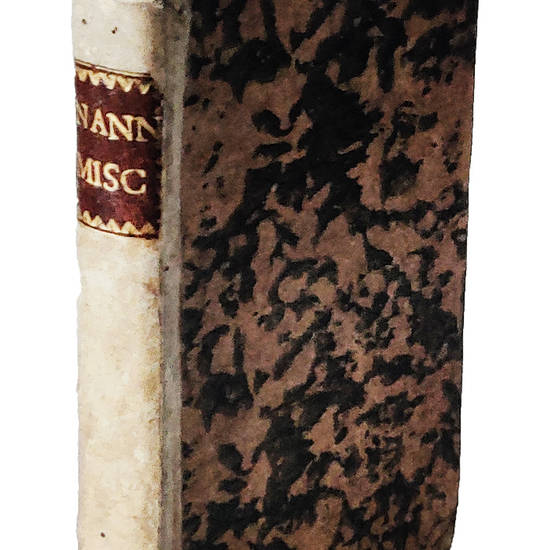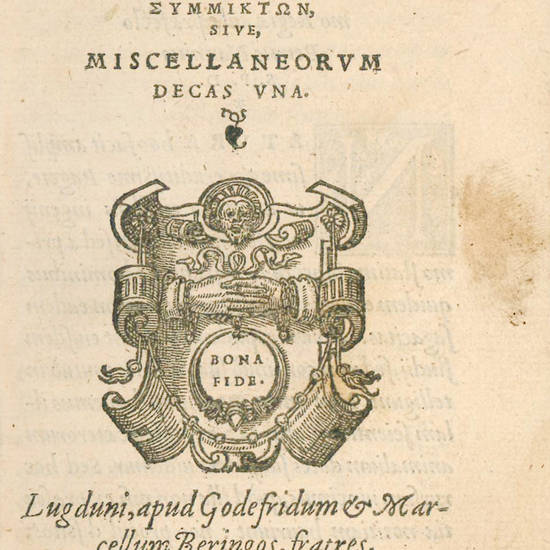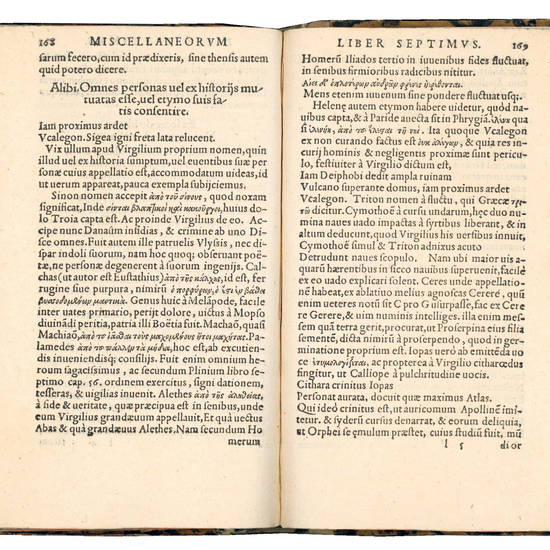8vo (139x84 mm). 263, [1] pp. Collation: a-q8 r4. Printer's device on the title-page. Late 17th-century half vellum, spine with gilt title on label, marbled edges. Light damp stain in the lower margin at the center of the volume, but all in all a good copy.
RARE FIRST EDITION of this collection of philological essays by this important Belgian humanist, mostly issued from his lectures at the Collegium Trilingue at Louvain. “Sans être volumineux, ce receuil est l'un de ceux qui ont le plus contribué à établir la renommée philologique de son auteur; il donne en effet, une idée générale de sa sagacité, de la moderation de son caractère et de l'étendue de son erudition” (A. Polet, Une gloire de l'humanisme belge Petrus Nannius, Louvain, 1936, p. 144). The work opens with a dedicatory letter to the English statesman William Paget, dated Louvain, June 1, 1548 (cf. Oxford Bibliographical Society, Proceedings & Papers, 1927, I, p. 210).
The ten books of the volume deal respectively with the interpretation of Terence (Books I & II); commentary on Horace (Book III: it also contains an account of Nannius' discovery of four ancient manuscripts of Horace in the library of the Benedictine monastery of St. Peter's Abbey, Ghent, or ‘Mont Blandin'. These were the so-called ‘Blandinian manuscripts', which were destroyed in a fire at the monastery in 1566); interpretation of some passages from the Satires and the Epistles of Horace (IV); commentary to some passages of Livy (Book V), commentaries on some passages of Virgil's Bucolica and Aeneid (VI & VII), defense of Erasmus against Robortello (Book VIII, see below); commentaries on some passage of Cicero (Book IX) and various commentaries on geology, etymology, comparative grammar, ancient astronomy, history, and Roman law (Book X) (cf. L. Laureys, Petrus Nannius als Philologe und Literaturkritiker im Lichte seines Kommentar's zur ‘Ars Poetica' des Horaz, in: “Transformations of the Classics via Early Modern Commentaries”, A.E. Enekel, ed., Leiden, 204, pp. 91-110).
The Italian humanist Franceso Robortello, nicknamed Canis grammaticus (‘the grammatical dog') for his confrontational and demanding manner, criticized in Variorum locorum annotationes (1543) some of Erasmus' paraphrases of Diogenes Laertius in the latter's Apophthegmata. “The shortcomings of Robortello's Annotationes were notices by Petrus Nannius, who devoted chapter VIII of his Miscellanea (1548) to the defense of Erasmus Apophthegmata. The first part of this chapter consist of a detailed discussion and, if possible, refutation of Robortello's notes. Contrary to Robortello, the Leuven professor shows a clear understanding of Erasmus' intention and method, without being blind to the errors he came across. He does not deny that the Italian critic was sometimes right, but disapproves of the acerbitas of his tone. Nannius quotes Robortello's annotations almost in full before discussing them. Sometimes he proves that Erasmus' interpretation was right. In other cases he tries to explain why Erasmus rendered the apophthegm as he did, or at least to mitigate the criticism. The second part of the chapter VIII, were Nannius corrects Erasmus' interpretation of nineteen other apophthegms, departs from the same benevolent attitude” (T.L. Ter Meer, Introduction, in: “Opera Omnia Desiderii Erasmi Roterdami. Ordinis Quarti. Tomus Quartus: Apophthegmata”, Leiden 2010, p. 21).
Petrus Nannius (Pieter Nanninck) was born in Alkmaar, where the first seeds for his later success was planted by Alardus of Amsterdam, who taught him Latin at the then famous local Latin School. His other teachers there were Bartholomew of Cologne, Rutger Rescius and Johannes Murmelius. In November 1518 he started his studies at the University of Louvain, where he probably met Erasmus. After his graduation he taught for a year at the Latin school of his native town and in 1521 was appointed rector of the Latin school of Gouda. During this time was published his comedy Victus (1522). When Erasmus died in 1536, Nannius contributed to the collection of epitaphs edited by Rutger Rescius (Louvain, 1537). And when his friend Conrad Goclenius died in January 1539, Nannius became his successor as Latin teacher at the Collegium Trilingue in Louvain, a position he held until his death. The great fame he acquired in this period is due to his commentaries on the writings of Horace, Cicero, Virgil and Lucretius. His correspondence gives a good impression of his international network of friends, scholars and politicians, including Nicolas Olah, later prelate of Hungary, Nicolas and Antoine Perrenot de Granvelle, Giacomo Fieschi, bishop of Savona, Stephen Gardiner, bishop of Wincester, the Portuguese humanists Damião de Goes and Achilles Statius, the English diplomat Nicholas Wotton, Edmond Bonner, bishop of London, the English humanist Roger Asham, Henri Estienne and many others (cf. A. Polet, op. cit., pp. 3-28 and H. de Vocht, History of the Foundation and Rise of the Collegium Trilingue Lovaniense, 1517-1550, Louvain, 1955, IV, pp. 460-461).
Adams, N-19; E.Cockx-Inedestege, Belgica Typographica 1541-1600, (Nieuwkoop, 1968-1994), no. 2189; Universal STC, no. 403083.
[4958]

